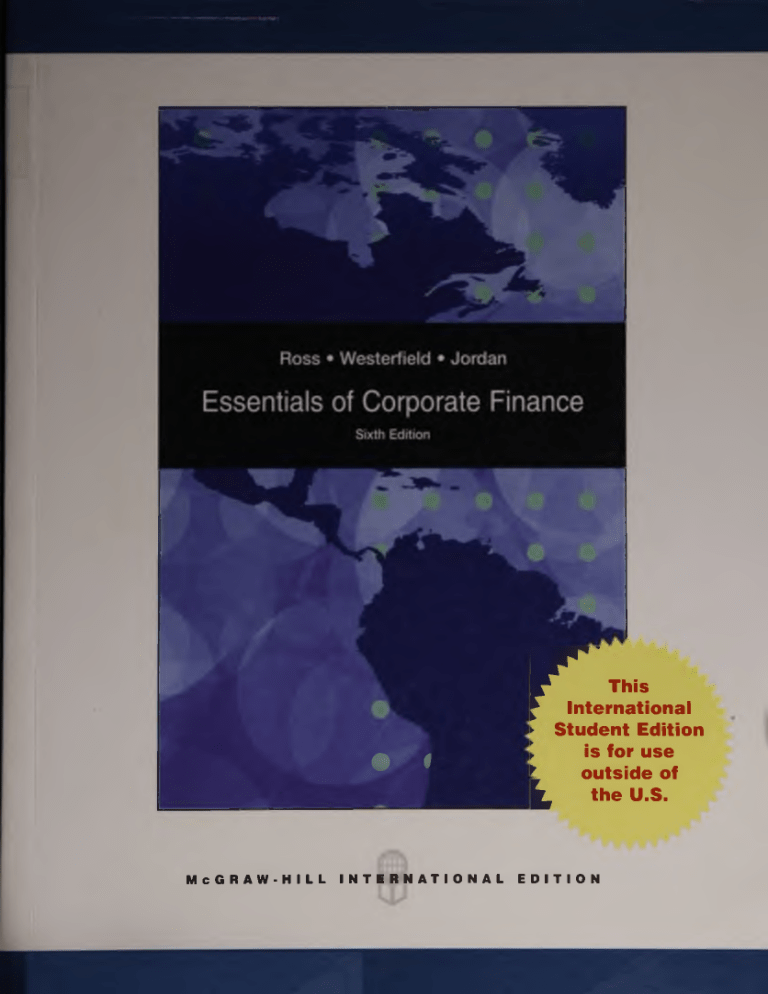
•
i
*1
McGRAW-HILL
INTERNATIONAL
r
This
r
P
International
► Student Edition
\
is for use
*
outside of
^
the U.S.
EDITION
'ON
Corporate Finance
Asian Network
for Higher Education
no
sixth
edition
.()02 5
Số hóa bởi Trung tâm Học liệu – ĐH TN
http://www.lrc-tnu.edu.vn
The McGraw-Hill/Irwin Series in Finance, Insurance, and Real Estate
Consulting Editor, Stephen A. Ross
Franco Modigliani Professor of Finance and Economics
Sloan School of Management. Massachusetts Institute of Technology
Saunders and Cornett
FINANCIAL MANAGEMENT
R oss, W este rfie ld , a n d J o r d a n
A d a ir
Excel A pplications f o r C orporate Finance
E ssentials o f C orporate Finance
F inancial M arkets a n d Institutions: An
Sixth Edition
Introduction to the Risk M anagem ent
F irst E dition
R oss, W este rfie ld , a n d J o r d a n
A pproach
B lock a n d H irt
F undam entals o f C orporate Finance
T hird Edition
F oundations o f F inancial M anagem ent
E ighth Edition
Twelfth Edition
S h e frin
B realey, M y ers, a n d A llen
B ehavioral C orporate Finance: D ecisions
E u n and Resnick
P rinciples o f C orporate Finance
That C reate Value
International F inancial M anagem ent
N inth Edition
F irst Edition
Fourth Edition
B realey, M y e rs , a n d A llen
W h ite
Kuemmerle
C orporate Finance, B r ie f E dition
F inancial A nalysis w ith an Electronic
C ase Studies in International
F irst Edition
C alculator
Entrepreneurship: M anaging an d Financing
B realey, M y ers, a n d M a rc u s
Sixth E dition
INTERNATIONAL FINANCE
Ventures in the G lobal Econom y
F irst E dition
F undam entals o f C orporate Finance
F ifth Edition
INVESTMENTS
B ro o k s
A d a ir
F inG am e O nline 5.0
E xcel A pplications f o r Investm ents
B ru e g g e m a n a n d F is h e r
B ru n e r
F irst Edition
R eal E state Finance a n d Investm ents
C ase Studies in F inance: M anaging f o r
B odie, K a n e , a n d M a rc u s
Thirteenth E dition
C orporate Value C reation
E ssentials o f Investm ents
C o rg e l, L in g , a n d S m ith
F ifth Edition
Seventh E dition
R eal E state Perspectives: A n Introduction to
C h ew
B odie, K a n e , a n d M a rc u s
R eal Estate
T he N ew C orporate Finance: W here Theory
Investm ents
Fourth E dition
M eets Practice
E ighth E dition
L in g a n d A r c h e r
Third Edition
H irt a n d B lock
R eal E state P rinciples: A Value Approach
D eM ello
F undam entals o f Investm ent M anagem ent
Seco n d E dition
C ases in Finance
N inth E dition
Sec o n d Edition
H irsc h ey a n d N o fsin g e r
G r in b la tt (e d ito r)
Investm ents: A n a lysis a n d B ehavior
REAL ESTATE
FINANCIAL PLANNING
AND INSURANCE
Stephen A. Ross, M entor: Influence through
F irst E dition
G enerations
J o r d a n a n d M ille r
M ah o n e y
G r in b la tt a n d T itm a n
F undam entals o f Investm ents: Valuation
R etirem ent Plans: 401(k)s, IRAs, a n d O ther
F inancial M a rkets a n d C orporate Strategy
a n d M anagem ent
D eferred C om pensation A pproaches
Seco n d Edition
Fourth Edition
Tenth Edition
FINANCIAL INSTITUTIONS
AND MARKETS
P erso n a l F inancial Planning
H e lfe rt
A llen, M elo n e, R o sen b lo o m , a n d
A ltfest
Techniques o f F inancial A nalysis: A G uide
to Value C reation
Eleventh Edition
F irst Edition
R ose a n d H u d g in s
H a rrin g to n a n d N ieh a u s
Higgins
Bank M anagem ent a n d Financial S e n ’ices
R is k M a n a g e m en t a n d Insurance
A n a lysis f o r Financial M anagem ent
Seventh E dition
Seco n d Edition
E ighth E dition
R ose a n d M a rq u is
K a p o o r, D lab a y , a n d H u g h e s
K e ste r, R u b a c k , a n d T \ifano
M oney an d C apital M arkets: F inancial
F ocus on P erso n a l F inance: A n A ctive
C ase P roblem s in Finance
Institutions a n d Instrum ents in a
A pproach to H elp You D evelo p Successful
Twelfth Edition
G lobal M arketplace
F inancial Skills
R oss, YVesterfield, a n d J a f fe
Tenth Edition
Seco n d Edition
C orporate Finance
S a u n d e r s a n d C o rn e tt
K a p o o r, D la b a y , a n d H u g h e s
E ighth Edition
F inancial Institutions M anagem ent: A Risk
P ersonal F inance
R oss, W e ste rfie ld , J a f fe , a n d J o r d a n
M anagem ent A pproach
E ighth Edition
C orporate F inance: C ore P rinciples
Sixth E dition
a n d A pplications
Số hóa bởi Trung tâm Học liệu – ĐH TN
F irst Edition
http://www.lrc-tnu.edu.vn
Essentials of
Corporate Finance
SI XTH EDI TI ON
Stephen A. Ross
Massachusetts Institute of Technology
Randolph W. Westerfield
University of Southern California
Bradford D. Jordan
University of Kentucky
¡ a McGraw-Hill
rrm Irwin
Boston Burr Ridge. IL
Dubuque, IA
New York
San Francisco St. Louis
http://www.lrc-tnu.edu.vn
London Madrid
Mexico City
Singapore Sydney Taipei Toronto
Số Bangkok
hóa bởi Bogota
Trung tâm
HọcKuala
liệu Lumpur
– ĐH TN
Caracas
Lisbon
Milan
Montreal
New Delhi
Santiago
Seoul
Me
Graw
Hill
McGraw-Hill
Irwin
ES SEN TIA LS O F C O R PO R A TE F IN A N C E
P ublished by M cG raw -H ill/Irw in, a business unit o f T he M cG raw -H ill C om panies. Inc.. 1221 A venue o f the
A m ericas, N ew York. NY, 10020. C opyright © 2008 by T h e M cG raw -H ill C om panies. Inc. All rights reserved.
N o part o f this publication m ay be reproduced o r distributed in any form o r by any m eans, o r stored in a
database o r retrieval system , w ithout the prior w ritten consent o f The M cG raw -H ill C om panies, Inc.. including,
but not lim ited to, in any netw ork o r oth er electronic storage o r transm ission, o r broadcast for distance learning.
Som e ancillaries, including electronic and print com ponents, m ay not be available to custom ers outside the
U nited States.
T his book is printed on acid-free paper.
P rinted in C hina
4 5 6 7 8 9 0 C T P/C T P 13 12 11 10
ISBN
978-0-07-128340-3
M H ID 0-07-128340-4
w w w .m hhe.com
Số hóa bởi Trung tâm Học liệu – ĐH TN
http://www.lrc-tnu.edu.vn
About the Authors
S te p h e n A . R o s s
R a n d o lp h W. W e s te rfie ld
B r a d fo r d D. J o r d a n
Sloan School of Management,
Franco Modigliani Professor
of Finance and Economics,
Massachusetts Institute
of Technology
Marshall School of Business,
University of Southern California
Gatton College of Business
and Economics,
University of Kentucky
Stephen A. Ross is the Franco
Modigliani Professor of Finance and
Economics at the Sloan School of
Management. Massachusetts Institute
of Technology. One of the most
widely published authors in finance
and economics. Professor Ross is
recognized for his work in developing
the Arbitrage Pricing Theory and
his substantial contributions to the
discipline through his research in
signaling, agency theory, option
pricing, and the theory of the term
structure of interest rates, among other
topics. A past president of the American
Finance Association, he currently
serves as an associate editor of several
academic and practitioner journals.
He is a trustee of CalTech and
Freddie Mac.
Randolph W. Westerfield is Dean
Emeritus of the University of
Southern California’s Marshall School
of Business and is the Charles B.
Thornton Professor of Finance.
He came to USC from the Wharton
School. University of Pennsylvania,
where he was the chairman of the
finance department and a member
of the finance faculty for 20 years.
He is a member of several public
company boards of directors including
Health Management Associates. Inc.,
and the Nicholas Applegate Growth
Fund. His areas of expertise include
corporate financial policy, investment
management, and stock market price
behavior.
Số hóa bởi Trung tâm Học liệu – ĐH TN
Bradford D. Jordan is Professor of
Finance and holder of the Richard
W. and Janis H. Furst Endowed
Chair in Finance at the University
of Kentucky. He has a long-standing
interest in both applied and theoretical
issues in corporate finance and has
extensive experience teaching all levels
of corporate finance and financial
management policy. Professor Jordan
has published numerous articles on
issues such as the cost of capital,
capital structure, and the behavior of
security prices. He is a past president
of the Southern Finance Association,
and he is coauthor of Fundamentals
of Investments: Valuation and
Management, 4th edition, a leading
investments text, also published by
McGraw-Hill/Irwin.
http://www.lrc-tnu.edu.vn
From the Authors
hen we first wrote Essentials o f Corporate Finance, we thought there might be a
small niche for a briefer book that really focused on w hat students with widely vary­
ing backgrounds and interests needed to carry away from an introductory finance course.
We were wrong. There was a huge niche! What we learned is that our text closely matches
the needs of instructors and faculty at hundreds of schools across the country. As a result,
the growth we have experienced through the first five editions of Essentials has far ex­
ceeded anything we thought possible.
With the sixth edition of Essentials o f Corporate Finance, we have continued to refine
our focus on our target audience, which is the undergraduate student taking a core course
in business or corporate finance. This can be a tough course to teach. One reason is that
the class is usually required of all business students, so it is not uncommon for a majority of the
students to be nonfinance majors. In fact, this may be the only finance course many of them
will ever have. With this in mind, our goal in Essentials is to convey the most important
concepts and principles at a level that is approachable for the widest possible audience.
To achieve our goal, we have worked to distill the subject down to its bare essentials
(hence, the name of this book), w hile retaining a decidedly modem approach to finance.
We have always maintained that the subject of corporate finance can be viewed as the
working of a few very powerful intuitions. We also think that understanding the “why" is
just as important, if not more so, than understanding the “how," especially in an introduc­
tory course. Based on the gratifying market feedback we have received from our previous
editions, as well as from our other text. Fundamentals o f Corporate Finance (now in its
8th edition), many of you agree.
By design, this book is not encyclopedic. As the table of contents indicates, we have
a total of 18 chapters. Chapter length is about 30 pages, so the text is aimed squarely at a
single-term course, and most of the book can be realistically covered in a typical semes­
ter or quarter. Writing a book for a one-term course necessarily means some picking and
choosing, with regard to both topics and depth of coverage. Throughout, we strike a bal­
ance by introducing and covering the essentials (there's that word again!) while leaving
some more specialized topics to follow -up courses.
The other things we have always stressed, and have continued to improve with this
edition, are readability and pedagogy. Essentials is written in a relaxed, conversational
style that invites the students to join in the learning process rather than being a passive
information absorber. We have found that this approach dramatically increases students*
willingness to read and learn on their own. Between larger and larger class sizes and the
ever-growing demands on faculty time, we think this is an essential (!) feature for a text in
an introductor}' course.
Throughout the development of this book, we have continued to take a hard look at
what is truly relevant and useful. In doing so, we have worked to downplay purely theoreti­
cal issues and minimize the use of extensive and elaborate calculations to illustrate points
that are either intuitively obvious or of limited practical use.
As a result of this process, three basic themes emerge as our central focus in writing
Essentials o f Corporate Finance:
W
An Em phasis on In tu itio n We always try to separate and explain the principles
at work on a commonsense, intuitive level before launching into any specifics. The
Số hóa bởi Trung tâm Học liệu – ĐH TN
http://www.lrc-tnu.edu.vn
underlying ideas are discussed first in very general terms and then by way of examples
that illustrate in more concrete terms how a financial manager might proceed in a given
situation.
A U nified V alu atio n A pproach We treat net present value (NPV) as the basic con­
cept underlying corporate finance. Many texts stop well short of consistently integrating
this important principle. The most basic and important notion, that NPV represents the
excess of market value over cost, often is lost in an overly mechanical approach that em­
phasizes computation at the expense of comprehension. In contrast, every subject we cover
is firmly rooted in valuation, and care is taken throughout to explain how particular deci­
sions have valuation effects.
Students shouldn't lose sight of the fact that financial manage­
ment concerns management. We emphasize the role of the financial manager as decision
maker, and we stress the need for managerial input and judgment. We consciously avoid
“black box” approaches to finance, and, where appropriate, the approximate, pragmatic
nature of financial analysis is made explicit, possible pitfalls are described, and limitations
are discussed.
A M a n a g e ria l Focus
Today, as we prepare to once again enter the market, our goal is to stick with and
build on the principles that have brought us this far. However, based on an enormous
amount of feedback we have received from you and your colleagues, we have made this
edition and its package even more flexible than previous editions. We offer flexibility
in coverage and pedagogy by providing a wide variety of features in the book to help
students to learn about corporate finance. We also provide flexibility in package options
by offering the most extensive collection of teaching, learning, and technology aids of any
corporate finance text. Whether you use just the textbook, or the book in conjunction with
other products, we believe you will find a combination with this edition that will meet
your current as well as your changing needs.
Stephen A. Ross
Randolph W. Westerfield
B radford D. Jo rd an
Số hóa bởi Trung tâm Học liệu – ĐH TN
http://www.lrc-tnu.edu.vn
Organization of the Text
W
e designed Essentials o f Corporate Finance to be as flexible and modular as pos­
sible. There are a total of nine parts, and, in broad terms, the instructor is free to
decide the particular sequence. Further, within each part, the first chapter generally con­
tains an overview and survey. Thus, when time is limited, subsequent chapters can be
omitted. Finally, the sections placed early in each chapter are generally the most important,
and later sections frequently can be omitted without loss of continuity. For these reasons,
the instructor has great control over the topics covered, the sequence in which they are
covered, and the depth of coverage.
Just to get an idea of the breadth of coverage in the sixth edition of Essentials, the
following grid presents for each chapter some of the most significant new features, as
well as a few selected chapter highlights. Of course, in every chapter, opening vignettes,
boxed features, and in-chapter illustrations and examples using real companies have been
thoroughly updated as well. Also, end-of-chapter material has been revised, and we have
included new “challenge” problems in many places in this edition.
C hapter 2
C hapter 3
Cash flow vs. earnings.
Clearly defines cash flow and spells out the differences
between cash flow and earnings.
Market values vs. book values.
Emphasizes the relevance of market values over book
values.
New material: Additional explanation of
alternative formulas for sustainable and
internal growth rates.
Expanded explanation of growth rate formulas clears
up a common misunderstanding about these formulas
and the circumstances under which alternative formulas
are correct.
New material: Price-sales ratios.
Explains price-sales ratios, emphasizing their usefulness
in cases where companies have negative earnings.
New material: EBITDA.
Explains the commonly used quantity earnings before
interest, taxes, depreciation, and amortization.
Số hóa bởi Trung tâm Học liệu – ĐH TN
http://www.lrc-tnu.edu.vn
PART THREE
Valuation of Future Cash Flows
C hapter 4
First of two chapters on time value
of money.
Relatively short chapter introduces just the basic ideas
on time value of money to get students started on this
traditionally difficult topic.
C hapter 5
Second of two chapters on time value of
money.
Covers more advanced time value topics with numerous
examples, calculator tips, and Excel spreadsheet
exhibits. Contains many real-world examples.
I PART FOUR
C hapter 6
C h apter 7
Valuing Stocks and Bonds
Bond valuation.
Thorough coverage of bond price/yield concepts.
Interest rates and inflation.
Highly intuitive discussion of inflation, the Fisher effect,
and the term structure of interest rates.
“Clean” vs. “dirty" bond prices and
accrued interest.
Clears up the pricing of bonds between coupon payment
dates and also bond market quoting conventions.
NASD's TRACE system and
transparency in the corporate bond
market.
Up-to-date discussion of new developments in fixed
income with regard to price, volume, and transactions
reporting.
“ Make-whole" call provisions.
Up-to-date discussion of relatively new type of call
provision that has become very common.
Stock valuation.
Thorough coverage of constant and nonconstant growth
models.
NYSE and Nasdaq Market operations.
Up-to-date description of major stock market operations.
New chapter case: Stock Valuation at
Ragan, Inc.
New case for this edition examines small company
valuation.
PART FIVE
Capital Budgeting
C hapter 8
First of two chapters on capital budgeting.
Relatively short chapter introduces key ideas on an
intuitive level to help students with this traditionally
difficult topic.
NPV, IRR. payback, discounted payback,
accounting rate of return.
Consistent, balanced examination of advantages and
disadvantages of various criteria.
N ew material: MIRR.
Thorough, but straightforward, coverage of modified
internal rate of return (MIRR) concepts and calculations.
N ew chapter case: Bullock Gold Mining.
New case for this edition examines basic capital
budgeting using a spreadsheet.
Project cash flow.
Thorough coverage of project cash flows and the
relevant numbers for a project analysis.
Scenario and sensitivity “what-if"
analyses.
Illustrates how to actually apply and interpret these tools
in a project analysis.
C hapter 9
PART SIX
Risk and Return
C hapter 10
Capital market history.
Extensive coverage of historical returns, volatilities, and
risk premiums.
Market efficiency.
Efficient markets hypothesis discussed along with
common misconceptions.
Geometric vs. arithmetic returns.
Discusses calculation and interpretation of geometric
returns. Clarifies common misconceptions regarding
appropriate use of arithmetic vs. geometric average
returns.
Số hóa bởi Trung tâm Học liệu – ĐH TN
http://www.lrc-tnu.edu.vn








